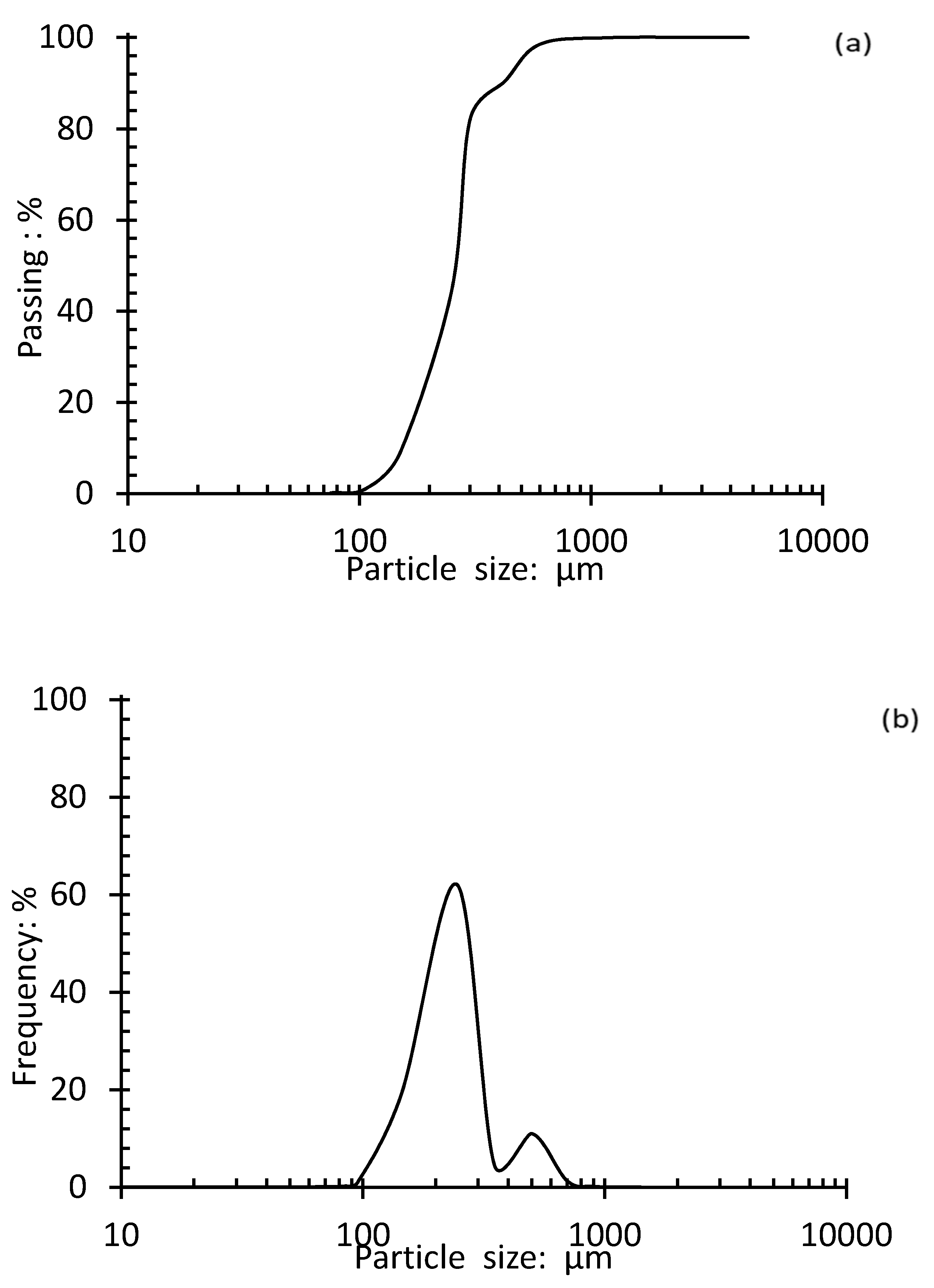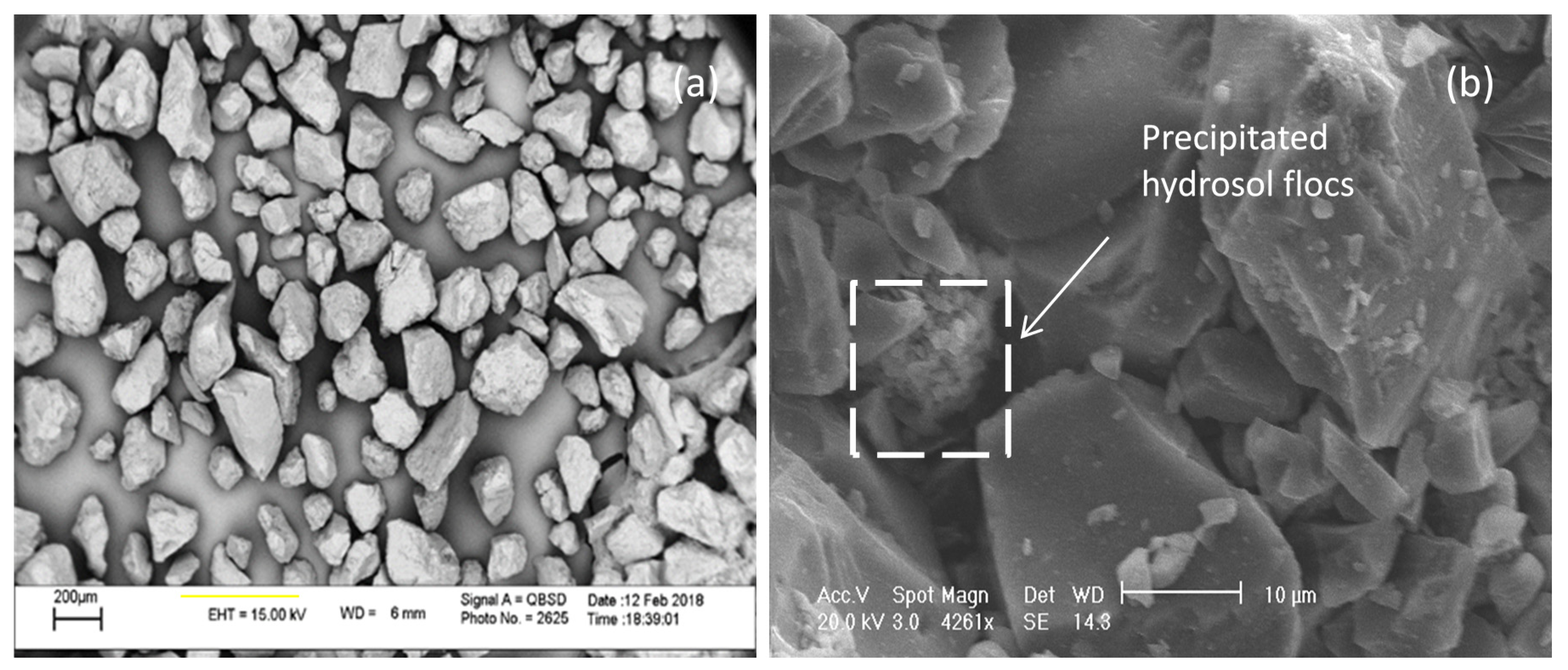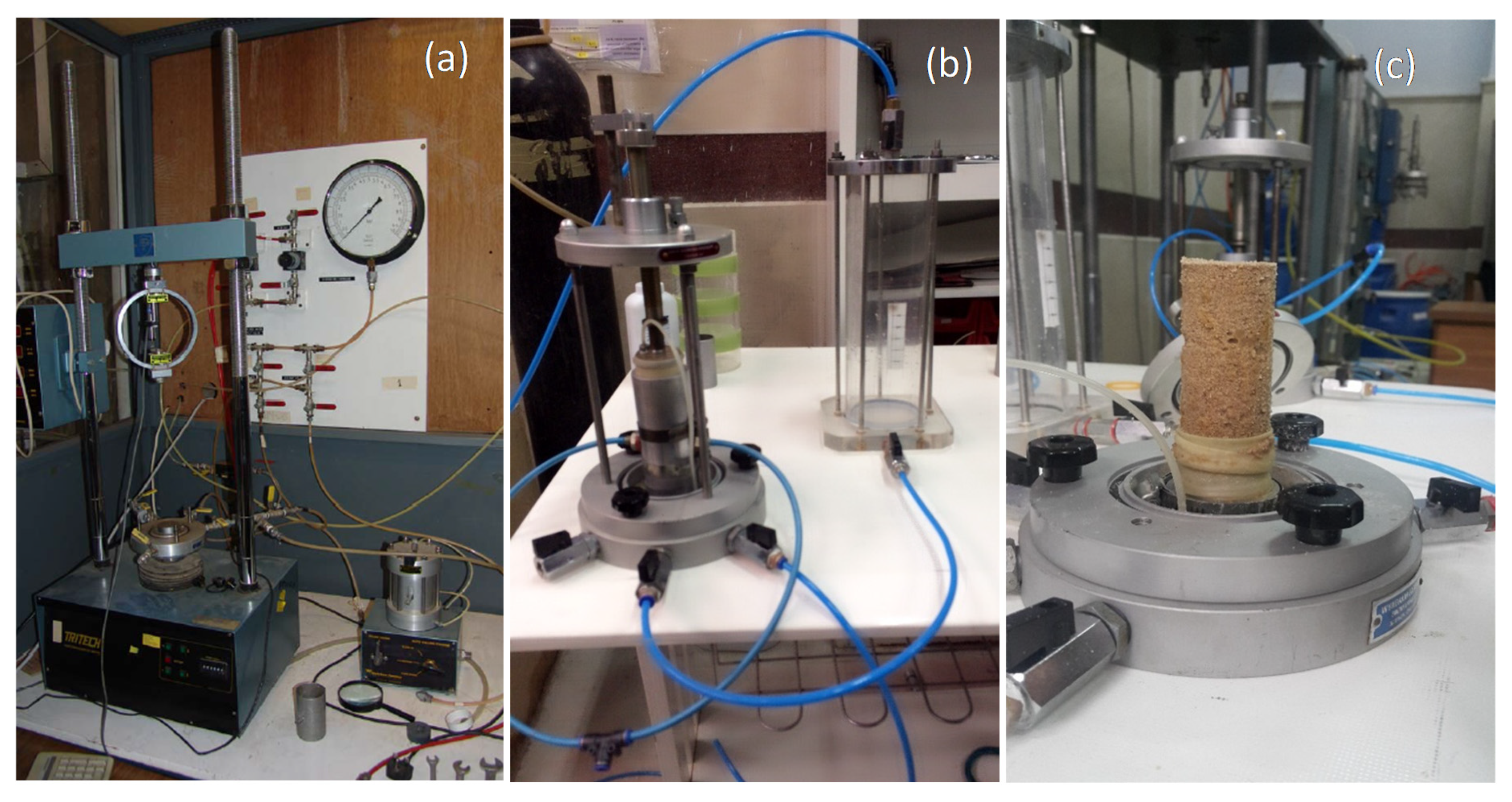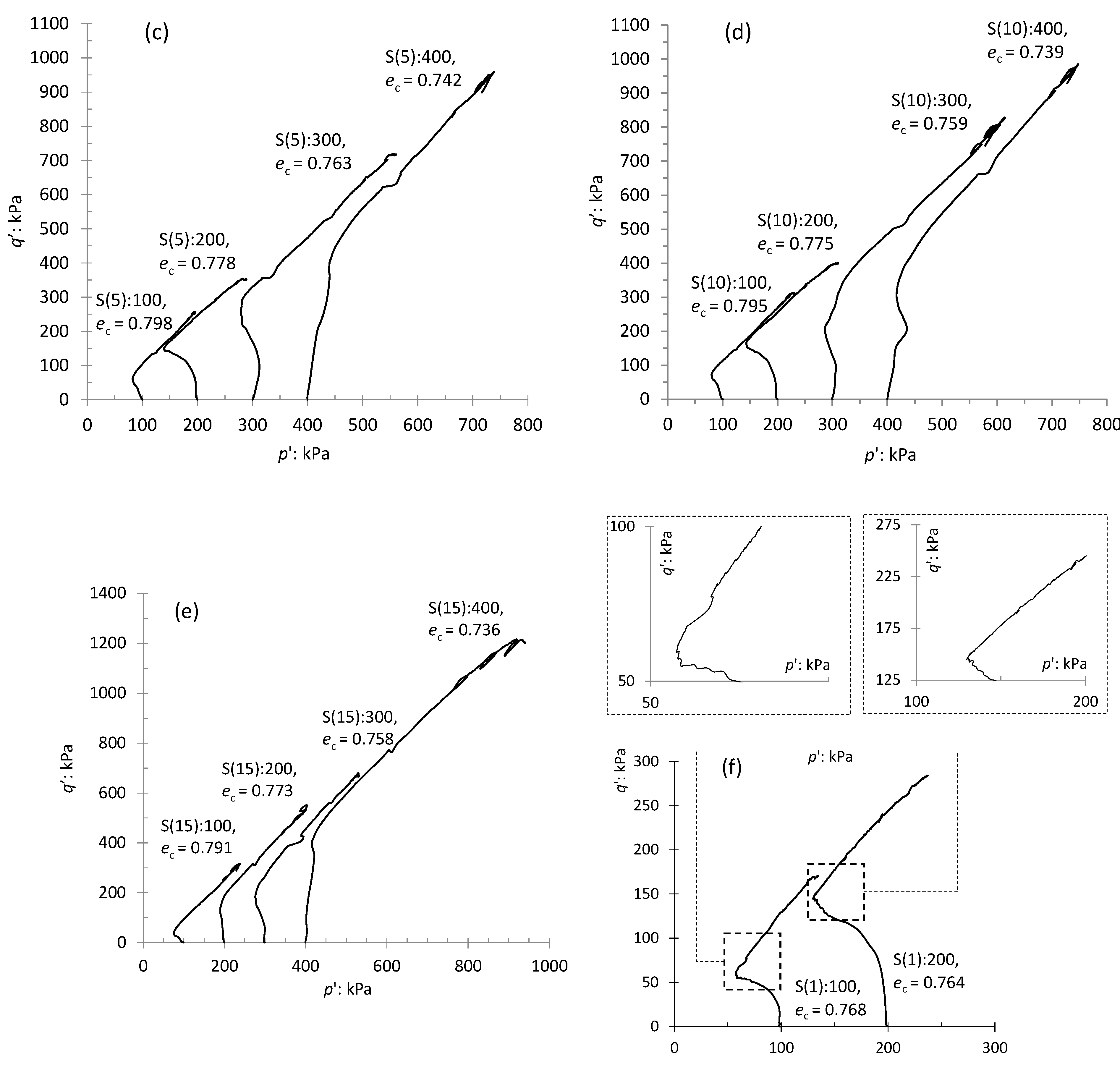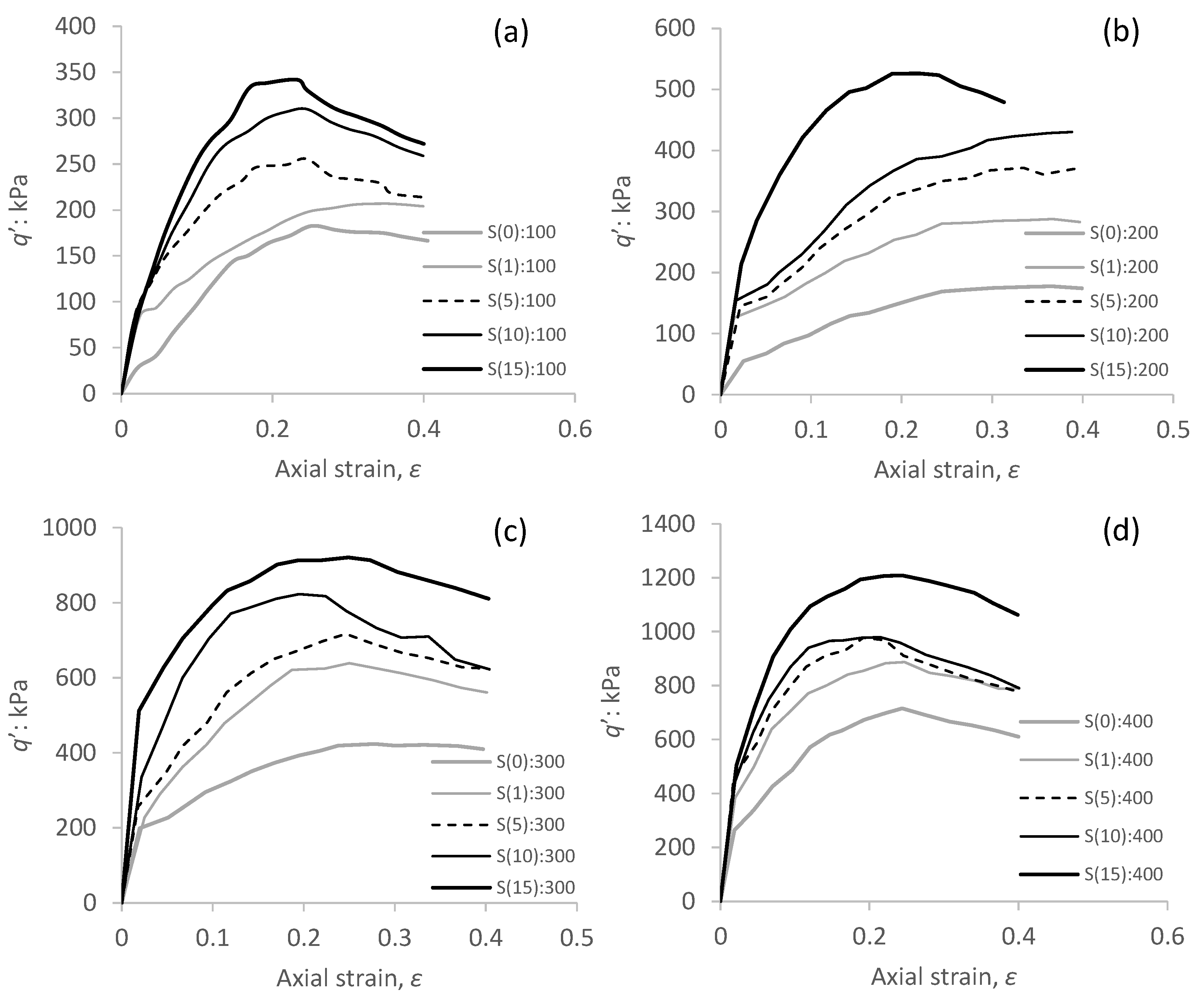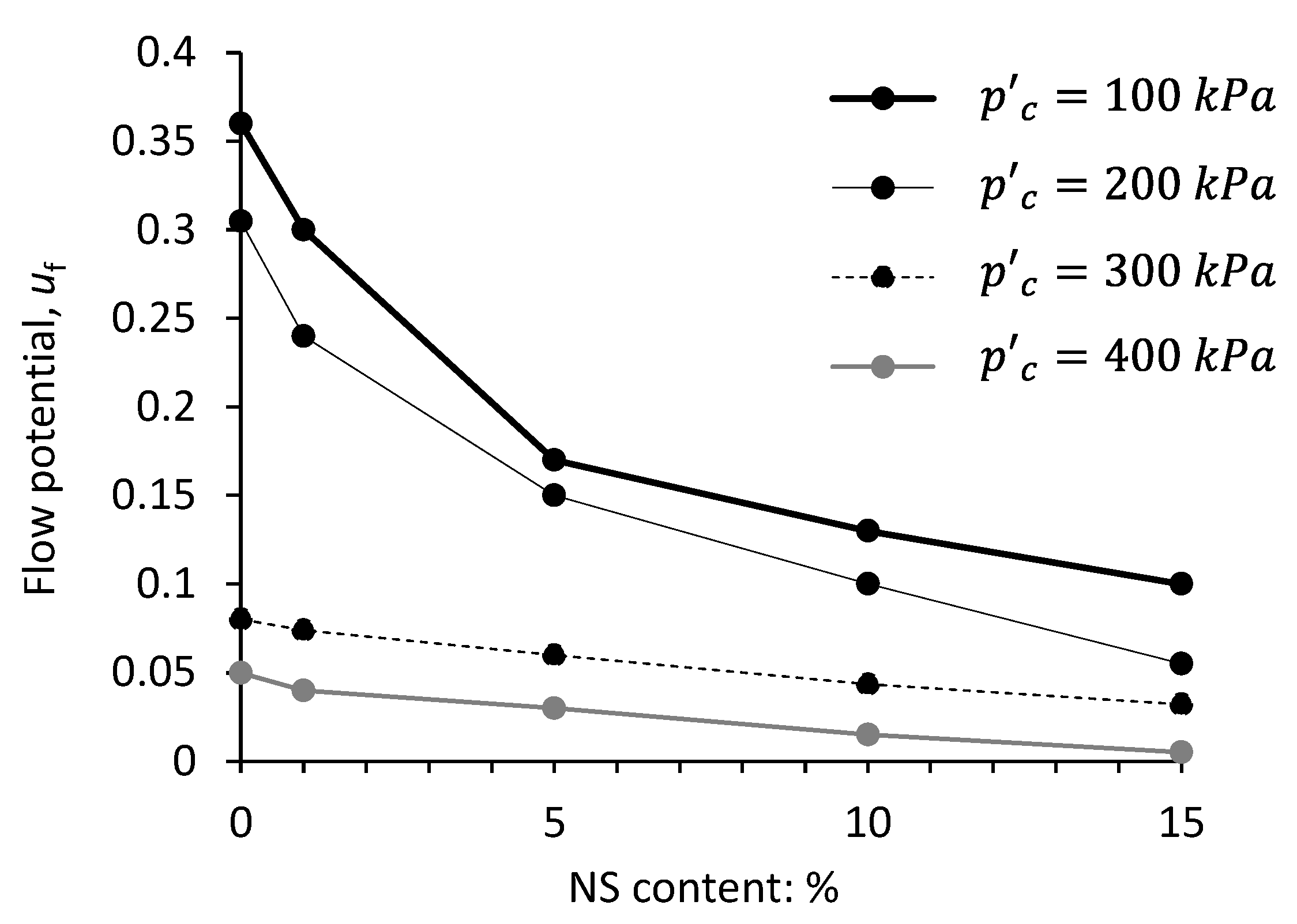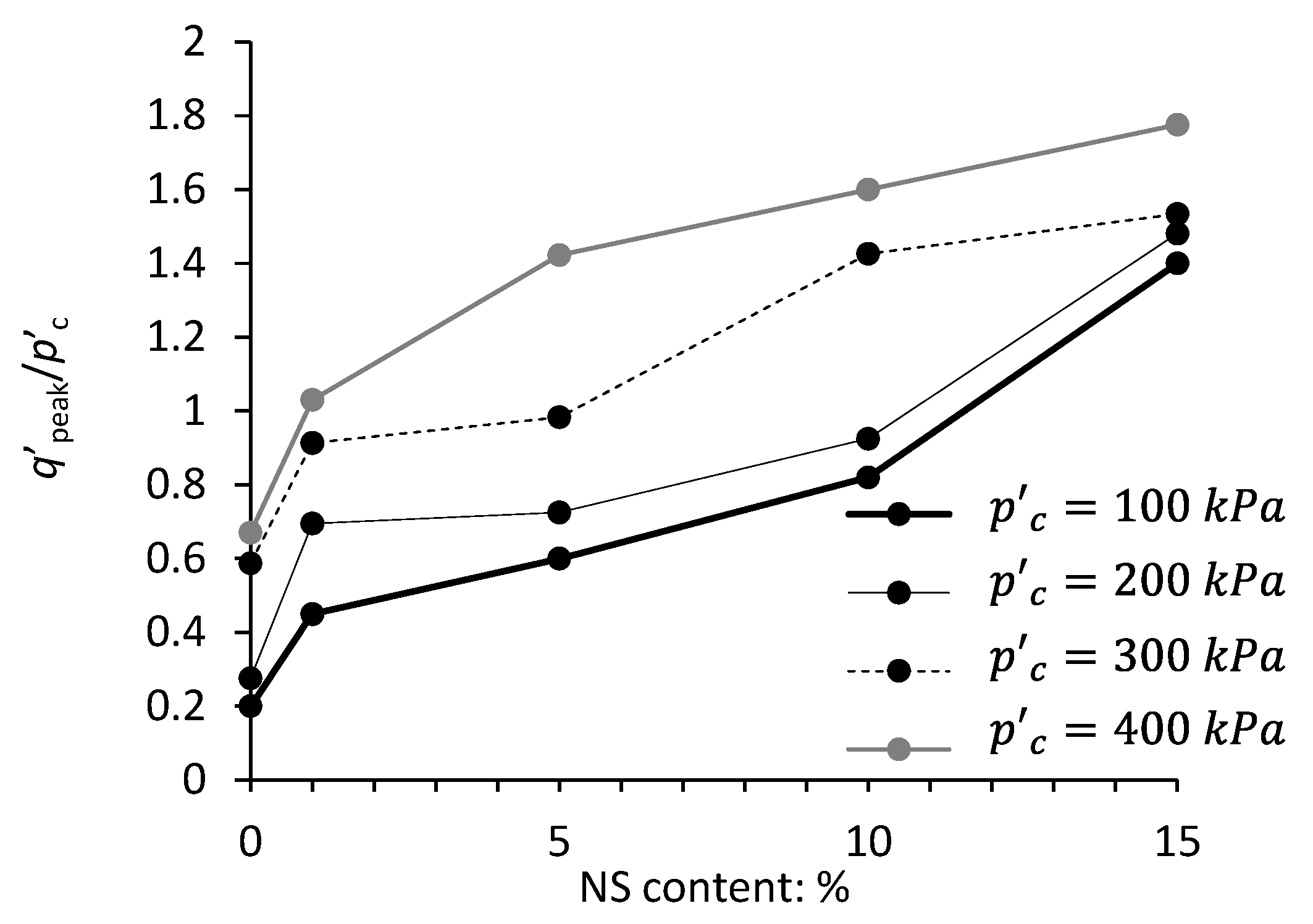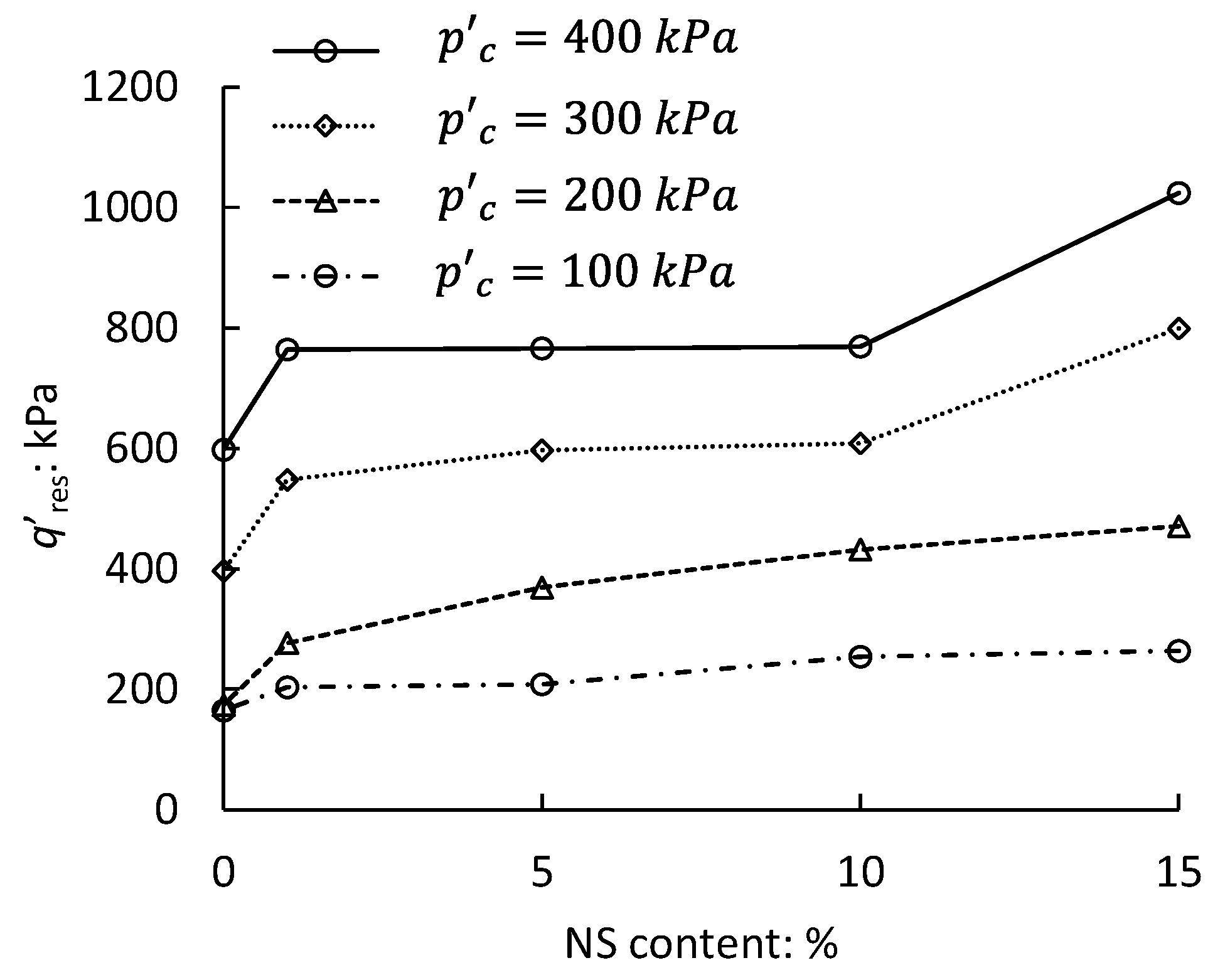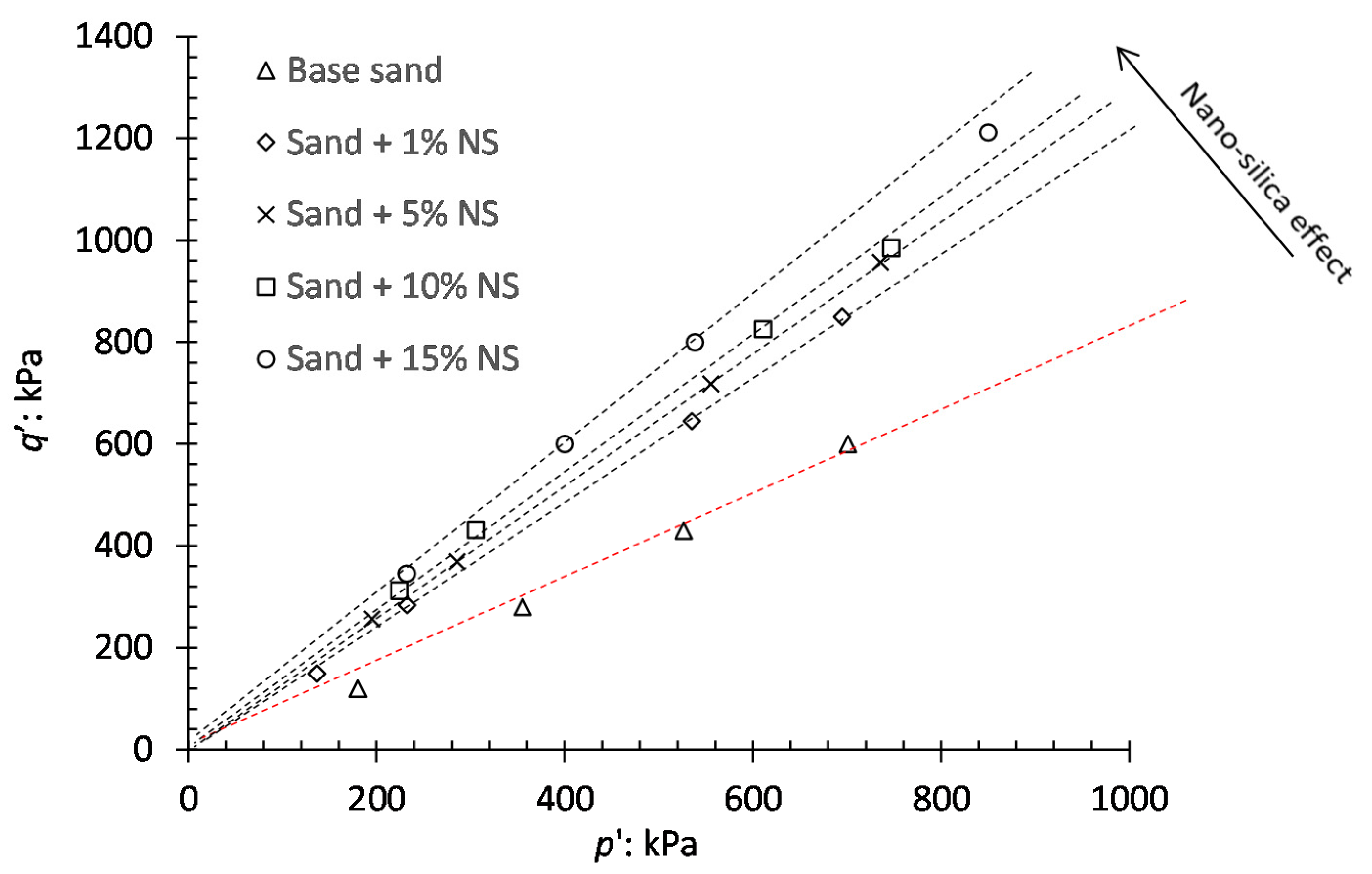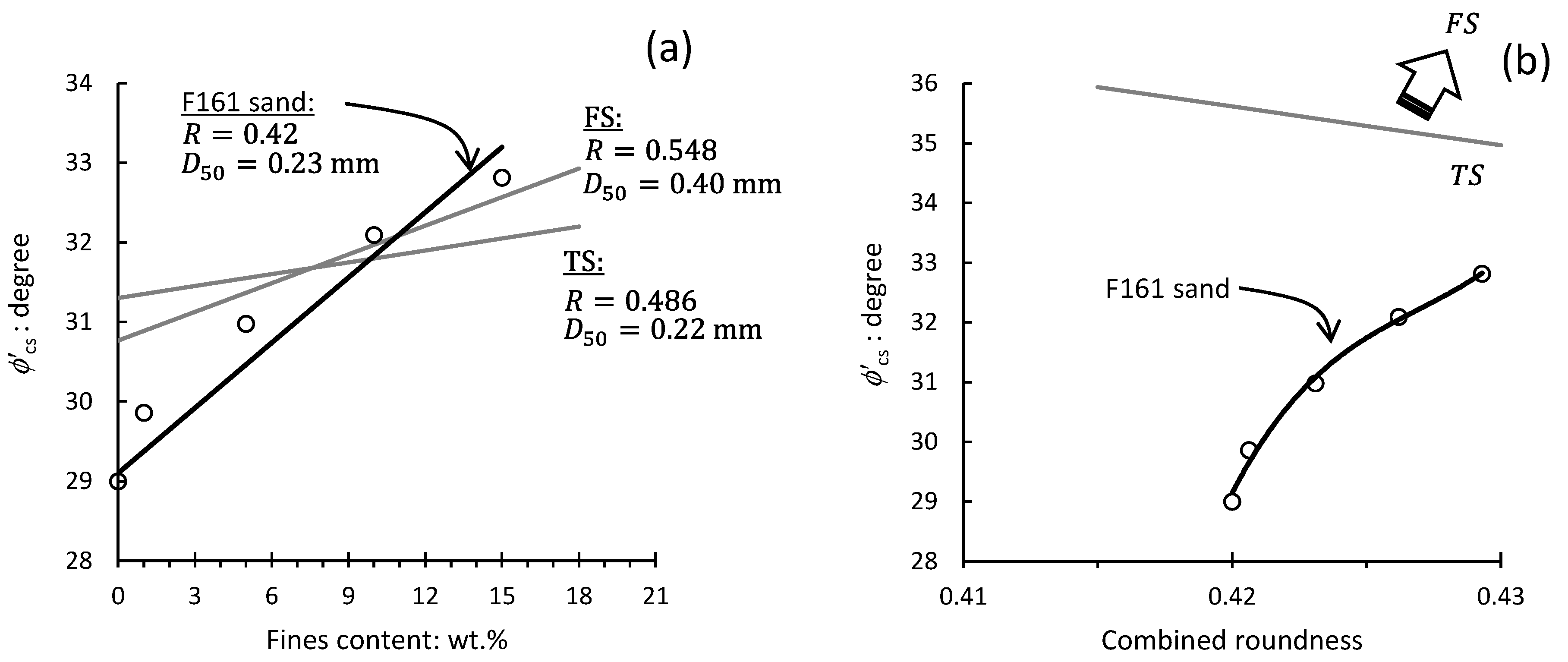1. Introduction
Monotonic loading of loose, saturated sand deposits may lead to the abrupt loss of shear strength and, as such, continues to be one of the most challenging problems in ground engineering [
1,
2]. The sudden strength loss that occurs for undrained conditions is also known as static flow or softening [
3,
4] and takes place before the effective stress path reaches the failure line. Static flow can have catastrophic consequences in natural and engineered earth systems, such as debris flow in sandy hillslopes. Fine particles in the sand can influence the likelihood and extent of softening, and has received extensive attention; seminal 20th century contributions, include [
5,
6,
7,
8]. Nevertheless, the role and implications of fines in loose sands remain somewhat disputed. For instance, Lade et al. [
9] reported on the formation of fresh collapsible structures in the sand upon the addition of non-plastic fines. Yamamuro and Covert [
10] had reported similar observations, but limited these unwelcomed skeletal structures to certain fines/sand ratio. Contractive response and flow in composite geomaterials were described in earlier works, including [
8]. These tied in with reported cases of diminished strength in silty sands [
6]. The unwelcomed impacts of the fines content were debated in [
11], where the addition of up to 40 wt.% of silica silt to Ottawa Sand was found to reduce the rapid shearing-induced collapsibility. Georgiannou [
12] subsequently reported a substantial reduction in brittleness for sands with 2.5 wt.% fines provided that the fines content was non-plastic. A series of more recent investigations have followed, which demonstrate the dependency of stiffness, yield, and the post-yield response of composite granular soils on fines content [
13], packing state, as well as the fines’ physicochemical properties [
14,
15,
16].
In making provision for establishing or extending the built settings on loose sands, research into binary geomaterials (saturated sand with various fines contents for the present investigation) led to the development of a diverse range of chemical stabilization techniques. These techniques share uncertainties inherited from the contradictory views on the impacting role of the fines content in sand. Chemical stabilization often causes significant disturbances that include altering the soil structural composition and/or physical properties, changing groundwater flow pathways, modifying the thermal properties of the ground, changing the soil mineralogical composition, and altering geochemical conditions. Furthermore, chemical stabilization invariably disrupts the soil biogeochemical cycles that emerge from the exchange and transport of matter and energy, which are driven by the interaction of the living organisms in the soils, a perspective currently often overlooked by the engineering profession. Among the plethora of chemical agents, siliceous-based grouts have minimal detrimental effects on ground functions. Hydrated sodium silicate (Na
2O.nSiO
2, 0.06–0.203 g/cm
3 density) was employed by Kaga and Yonekura [
17] for stabilization of five sands of diverse gradations, with emphasis on the role of sand relative density (
Dr—that is, a packing proxy parameter) on strength of the composites. In examining the reduction in erodibility of standard-Proctor compacted medium silica sand for treatment using 1–4 wt.% NS additive of 11–13 nm particle size, Zomorodian et al. [
18] reported a six-fold improvement in hydraulic erosion resistance for the optimum performing concentration of 1.5 wt.% NS achieved after a remarkably short one-day curing. Kodaka et al. [
19] used a low-viscose solution of colloidal silica (4 wt.% silica), with mean particle size,
D50, of 10 nm, to stabilize poorly-graded Toyoura sand (
D50 = 0.2 mm) for demonstration of the remarkable role of nano-particles in eliminating liquefaction and collapsibility potentials investigated under cyclic torsional stress conditions. Tsukamoto et al. [
20] combined Toyoura sand (
D50 = 0.17 mm) with 6 wt.% silicate-based solution (i.e., acid silica sol) for investigation of enhanced undrained cyclic resistance as a function of small- and large-strain stiffnesses. A series of more recent works on the use of colloidal silica (aqueous silica nano-particles) have followed, as grout in soils ranging from liquefiable sands [
21,
22,
23,
24] to kerosene-contaminated sandy clay [
25].
The present investigation demonstrates findings from a series of monotonic undrained triaxial compression tests to study the impact of NS-treatment on the static flow (i.e., static liquefaction) of saturated medium-dense clean angular sands, and to determine the steady-state parameters. Through a control on the normality of saline solution and pore water temperature, the gelation time was lowered to attain coagulated rounded porous hydrated silica flocs at constrictions between neighboring sand grains. The specimen shearing continued to reach or closely approach the critical state, leading to the development of a novel critical state soil mechanics (CSSM) framework for NS-treated sands. The impact of sand and silica-floc size, and shape are discussed b contrasting macro-scale findings with those of standard Toyoura and Fujian sands, and also through qualitative particle-scale events. The latter gains stimulus from two directions. Firstly, the informed design of NS grouts for groundworks is relevant. For instance, in the context of the well-established passive-site stabilization technique [
22], substantial decrease in vertical strains (from the 2–2.5% levels expected in untreated sands to 0.1–0.3% in NS-mediated sands) upon dynamic motions offer remarkable liquefaction resistance, but ground motion amplifications in certain depths continue to pose restrictions to the feasibility of the method. The local excessive amplifications mark potential degradation in sand particles’ adhesion (following grout injection) and possible incomplete gelation of NS grouts. Shape and size of sand grains and silica flocs, as well as soil structure and packing state, play pivotal roles within the mechanisms that leads to NS gelation. To have a better control on induction and gelation time that satisfies the intended grout reach and homogeneity, while retaining the ecosystem service provision. Engineers will have to face the challenge of adopting material compositions and implementation methods in an informed manner, possibly by gaining particle-level insight. Secondly, discussion of particle-level events could be used for predictive purposes. In the context of multi-modal soils, e.g., NS-mediated sands, predicting stress paths that could lead to static flow and the problematic progressive loosening can be of interest in design of more resilient engineered subgrades, embankments, and flood defense systems. For engineered sands, stress-strain response and mechanisms controlling the onset of flow and critical state are most complex, but can be intuited from particle-scale insights.
This study is an investigation as to what extent the mechanical behavior (under axial-symmetric stress conditions) of the sand compares, with the mixtures providing evidence of the influence of the structure of the materials on their mechanical response. The main emphasis is on the post-yield response of the test materials. The findings from this work will be of particular interest to practitioners with an interest in employing NS grout for remediation of distressed sandy earth systems.
3. Undrained Shear Behavior for Binary Mixtures
A series of undrained triaxial compression tests was performed on the base and treated sand specimens, investigating 1%, 5%, 10% and 15% NS contents. The specimens were sheared monotonically by axial compression to >40% axial strain in order to reach or closely approach the critical state.
Table 5 presents a summary of the testing program and steady states.
Figure 6 shows the shear responses in the
plane of the base sand and four NS-treated sand mixtures. Stress paths are plotted for four initial mean effective stresses (
= 100–400 kPa), with the post-consolidation void ratio (
ec) adopted as the basis for comparison.
Two immediate observations are discussed here: (1) the variation in
ec with
p′
c was marginal for all test specimens, as one would expect for saturated granular soils; (2) for both base sand and binary mixtures, greater confining pressures diminished the strain-softening. These points collectively illustrate the significant control of confinement pressure on the post-yield behavior of saturated granular materials. The addition of colloidal NS to the F161 sand generally decreased the strain-softening response, as compared with the base sand at a nearly similar void ratio. To test this observation, the mean effective stress at phase transformation (
) is adopted here as a proxy parameter. That is, the phase transformation marks the transition from a structurally metastable state to a more stable state, when a local minimum shear strength is reached, and further straining increases the average number of sand particle-to-particle contacts. To demonstrate, the phase transformation (
) for the base sand and binary mixtures comprising 10% and 15% NS contents are compared. An initial effective stress (
p′
c) of 200 kPa is adopted as it was found to produce the minimum variations of void ratio with NS content (
Figure 4). The post-consolidation void ratio values for specimens S(0):200, S(10):200 and S(15):200 were 0.783, 0.775, and 0.773, respectively. This marks a gentle but negligible decrease in void ratio upon grout treatment. With reference to
Figure 6a, phase transformation was reached at a low
of 142 kPa for base sand, indicating a strong strain softening. For S(10):200 and S(15):200,
increased to 151, and 180 kPa, respectively (see
Figure 6d,e), marking a much lower
, and hence relaxed strain-softening. Our findings indicate that grouting sand with NS leads to a gradual transformation of the base sand into a geocomposite possessing stiffer, more brittle, and more dilative stress-strain behavior. This transition appears to be controlled by the mean effective stress—that is, in
Figure 6a–c, the strong strain softening in base sand for low
(≤200 kPa) continues to appear for the 1–15% NS-treated sand specimens, but vanishes at greater
levels. Referring to the characteristic stress path in
Figure 5a, the transition footprint can be seen in the experimental
traces presented in
Figure 6b–c and in the
traces through the initial stage of shearing, with
kPa, where binary mixtures with <5% NS content exhibited some clearly visible minor fluctuations in the stress paths (
Figure 6a–b). These perturbations (
Figure 6f) were less pronounced at the higher
levels investigated. These volatilities could indicate a period of rapid interactions between the sand particles and rounded NS floc units, suggesting particle rearrangement and, as such, turmoil in inter-particle forces. This period lasted until the sand particles attained a more stable packing state.
Referring to
Figure 7b, the perturbations in the
trace for specimen S(1):200 ceased at axial strain levels above 2.5% (i.e., >0.025 on the graph). Further, the
trace dips at approx. 2.5% axial strain, and the stress path changes direction (see
Figure 6b), marking a state, at which the specimen achieves a local minimum shear strength ahead of strain-hardening. This transition is effectively an event that marks the most pronounced loss of sand particle-to-particle contacts. The subsequent strain-hardening period leads to an increase in the mean numbers of particle-to-particle contacts with increasing strain. Here, the 2.5% axial strain represents a transition point from an initial metastable to a more stable packing state. It will be shown later that the role of NS at this ‘threshold’ 200 kPa mean effective stress is optimum, resulting in maximum peak deviatoric stress.
The observations on plastic volumetric behavior of the base and NS-treated sands are better described in quantified forms, which necessitates the definition of a state index. Flow potential (
) is adopted here as an appropriate state index. Yoshimine and Ishihara [
35] first suggested the use of
, the maximum excess pore-water-pressure ratio, as a measure of softening. The
index is controlled by stress conditions in the sand during both initial and shearing stages. Equation (3) formulates the flow potential as a function of
(mean effective stress at the PT point) and
(mean isotropic effective confining pressure):
The variation of the flow potential with NS content is presented in
Figure 8 for the base and modified sands. Relatively higher flow potential values were measured for base sand specimens under the lowest confining pressures investigated. Generally, the flow potential appears to be approx. indirectly proportional to NS content and the
level.
The above findings are consistent with similar attempts (but with different chemical grout proppants employed) in the investigations by Gallagher [
39], Rodríguez and Izarraras [
40] and Towhata and Kabashima [
41], and also where cement was used as additive in the studies by Clough et al. [
42] and Saxena et al. [
43]. As described earlier, NS treatment had minimal impact on the post-consolidation void ratio and packing state of the sand specimens but reduces strain-softening behavior.
The q′–
traces presented for the base and NS-treated sand specimens in
Figure 7a–d indicate that the deviatoric stress at USS (ultimate steady state) increases with NS content and, furthermore, the specimens behave explicitly stiffer and exhibit a predominantly dilative response. This occurs on account of the increased bonding effect of NS flocs at sand particle level for greater NS content. It was argued earlier that silica bonding units begin to disrupt upon isotropic consolidation as the mean effective stress is increased beyond 200 kPa. In other words, particles are argued to have benefitted from maximum bonding for
< 200 kPa. This seems to be a threshold mean effective stress and has its footprints on the stress path traces—that is, for
> 200 kPa, the stress path traces in
Figure 7a–d exhibit some erratic and sporadic fluctuations which are thought to be macro-scale reflections of frequent particle contact modifications. Upon shearing, and particularly at strain levels above the PT when particles are fully engaged, straining results in small movements of the interparticle spherical NS flocs. Sand grains frequently lose and re-establish contact as shear strains are built up. The fluctuations described first appeared for
= 200 kPa and coincided with the PT, ahead of the strain softening.
Sand Modification and Shear Strength
For the NS range of 0–15% investigated, greater NS content generally produced an increase in failure shear strength,
. Treated sand isotropically consolidated at
= 200 kPa experienced the greatest rise in
, which is consistent with earlier discussions on the significance of
= 200 kPa as the threshold confining pressure. By adding 15% NS, the
for confining pressures of 100, 200, 300 and 400 kPa increase by 95%, 201%, 115% and 69%, respectively, compared to the untreated sand. At particle level, this is mainly due to improvements in first stage bonding (enhanced cohesion) that produces the enhanced deviatoric stress of the treated specimens. This observation is supported by computed relative improvements in failure apparent cohesion and effective friction angle (
,
). In other words, compared to the base sand, the 1%, 5%, 10% and 15% NS contents mobilized greater
of 73%, 250%, 450%, and 750%, respectively. Whereas, the corresponding improvements in
were limited to 5%. To better understand the relationship between mean isotropic effective confining pressure and peak strength, the normalized peak shear strength (
) is plotted against NS content in
Figure 9.
Referring to
Figure 9, over the NS range of 0–15%, greater NS content produced an increase in
, with maximum levels appearing at 15% NS for all confining pressure levels investigated. Similar findings have been reported by [
44,
45]. Note that the 15% NS content is lower than the threshold fines content beyond which the overall behavior of the binary mixture would be controlled by the fines. For < 15% NS content, however, the rounded silica flocs locate in between the sand particles to build an open packing on the 600 (loose) to 402 (fairly loose) packing transition route described earlier in the paper. The chains of sand and rounded silica flocs enjoy the generally enhanced coordination number (i.e., contact number per particle) and transmit greater levels of skeletal stresses.
In
Figure 10, axial strain at failure deviatoric stress (
) is plotted against NS content and indicates that strain at failure state decreased with increasing NS content for all confinement levels investigated. This confirms a more brittle dilative response for the treated sand compared to the base sand.
Failure strain also decreased with increasing mean effective stress (), with the maximum decrease occurring for 15% NS, while the largest recorded drop was for = 200 kPa. That is, compared to the base sand, for the 15% NS-treated sand decreased by 24%, 36%, 35%, and 27% for = 100, 200, 300 and 400 kPa, respectively. This lends further evidence to the significance of micro-structural events that take place at the ‘threshold’ 200 kPa mean effective stress.
In
Figure 11, residual deviatoric stress (
) is plotted against NS content for the four mean effective confinement stress levels investigated. This figure indicates a gentle increase in
for up to 10% NS, followed by a more marked increase for increasing NS content from 10% to 15%. As expected, confinement pressure has a clear direct impact on
. Once the specimens are sheared beyond the PT point, silica flocs migrate and ‘stuff’ the macro-pore spaces, thereby providing support to direct sand particle-to-particle contact points. Such support allows sand asperities to carry greater levels of skeletal stresses and, as such, the soil develops greater levels of residual shear strength.
Overall, the experimental results presented in
Figure 11 suggest that the effectiveness of fine inclusions in improving the residual shear strength for the investigated sand is limited to NS contents >10% and for
≥ 200 kPa. At
= 200 kPa, treatment is most effective at 15% NS content.
5. Commercial and Environmental Compatibility
The last 70 years have seen a rise in research and use of inorganic engineered nano-particle materials (ENMs) in electronics, automotive, aeronautical and construction industries [
48]. Given the typically lighter, stronger and more energy efficient properties of ENMs, AECOM predicted that over 50% of building materials will contain nanomaterials by 2025 [
49]. The share of nanotechnology in building materials, however, is generally likely to be smaller. This is mainly, due to the uncertainty and misinformation in relation to these materials, the confused definition of them across the construction industry and regional and national standards, current limited knowledge of them by constructional professionals, their uncertain environmental, toxicological and ecotoxicological implications [
50], their likelihood of dissolution and spread into the environment and subsequent human exposure, difficulties in measurement and mitigations measures, and commercial viability. With the latter, among the 156 nano-enabled construction products developed, to-date [
51], many fail to be converted into marketable products and have remained at early stages of development with little chance of commercial viability.
Over the past 50 years, NS has been broadly used in pharmaceutical, food, textile, printer toner, cosmetics, paint and coating (silane, siloxane and polysilazane), medical and drug products [
50], and has scope to be used at industrial level as low-viscose grouts for ground improvement purposes, including compensation grouting for submerged excavations [
52], permeation grouting for geological containment and storage of hazardous wastes, and corrective grouting in fractured rocks. In comparison with cement, NS grouts offer a control on the induction and gel time, and also better penetrability in finer soils. This, together with their suitable mechanical properties, allows their application to soil via non-disruptive low-gradient delivery [
22]. The undrained mechanical properties of NS-treated sands were studied in previous sections. The economical and environmental viability of NS grout and their possible implications for application of a 5% solution in 1 L of saturated porous sand of 1530 kg/m
3 bulk density is briefly discussed below.
5.1. Environmental Viability
Wang et al. [
50] used probabilistic material flow modelling to study the possible environmental risks of NS in the environment. For the EU zone, they showed that the predicted environmental concentration (PEC) of NS in surface water ranges from 0.053–3.3 µg/kg, and as high as 60 µg/kg in shallow soils. For this estimation, they assumed that 10% of the total NS consumption—that is a modest 18,000 tonne/year—is released to the environment. From a toxicological perspective, dissolved silica is only toxic at concentrations well-above the solubility limit, in the hundreds of mg/L range [
53]. From an ecotoxicological perspective, exposure of micro-organisms (e.g.,
P. subcapitata, D. magna, …) to PECs above 0.4 g/L can lead to a nearly 50% mortality rate. For 5% NS concentration in typical saturated sandy soil, the PEC of nano-silica in soil totals around 76 g/L. As such, compared to traditional calcium-based proppants, NS is relatively less harmful and should impose no direct environmental risks to humans for controlled and contained groundwork applications; although the likely impacts on microorganisms need to be further established. Assadi-Langroudi [
47] showed that synthetic amorphous silica (NS being a peculiar form of which) in granular soils appears in two different forms of dispersed coating units and sub-rounded flocs (precipitation conditions dependent). He showed that NS flocs with rounded globular (as seen in the present work-
Figure 2b) or short tangled laminar shape are less likely to be dislocated by groundwater flow from the particle-level sites into the groundwater, thereby posing little environmental risk at strictly local levels (also see [
54]).
5.2. Commercial Viability
NS has been used as additive in the concrete and insulation industries for over 30 years. Ultrafine powder (approximately 150 nm in size) silica fume and NS (5–100 nm in size) have been used in concrete to provide rapid strength gain, enhanced strength, better durability, and surface finish. Silica fumes are widely available in the UK and across the globe. Although, it is not often marketed as nanomaterials by manufacturers. These are expensive products and are only modestly adopted in commercial settings. In a smaller scale, NS is infrequently used as an insulator and in the form of silica aerogels. These are readily available on the market, but their broad use is blighted by their typically 6 to 10 times higher costs in comparison with traditional, but less efficient, insulation products [
51].
In fractured rocks and soil, the main practical advantages of NS are high penetration capacity and a chance of controlling the gelling time and hence the penetration depth. For a 5% NS solution, treatment of each cubic meter of sandy soils (of a porosity of 35%) on average costs around US
$ 60 [
55]. This is relatively lower than the treatment costs incurred using other alternative non-cement-based grouts (that offer better penetrability than cement), including polyurethane, epoxy resin, acrylamide, methacrylate, acrylate, and sodium silica. For example, treatment of one cubic meter of sand with acrylamide, on average, costs around US
$ 325. Apart from the higher cost, recent environmental leakage incidents (e.g., in Romeriksporten tunnel, Norway and Hallandsås tunnel, Sweden, reported in [
56]) cast doubt on the suitability of these materials for permeation grouting.
NS is commercially available as low viscosity grout in gel state with a strict use-by-date. Examples are CemSyn manufactured in India, Meyco MP320 manufactured in Sweden and MP320T manufactured in Germany. The main difference between these commercial products is their silica content and particle specific surface area values [
57].
